New Power Quality Analysis Method Based on Chaos Synchronization and Extension Neural Network
Abstract
:1. Introduction
2. Power Quality Disturbances and Basic Architecture of Proposed Power Quality Analysis System
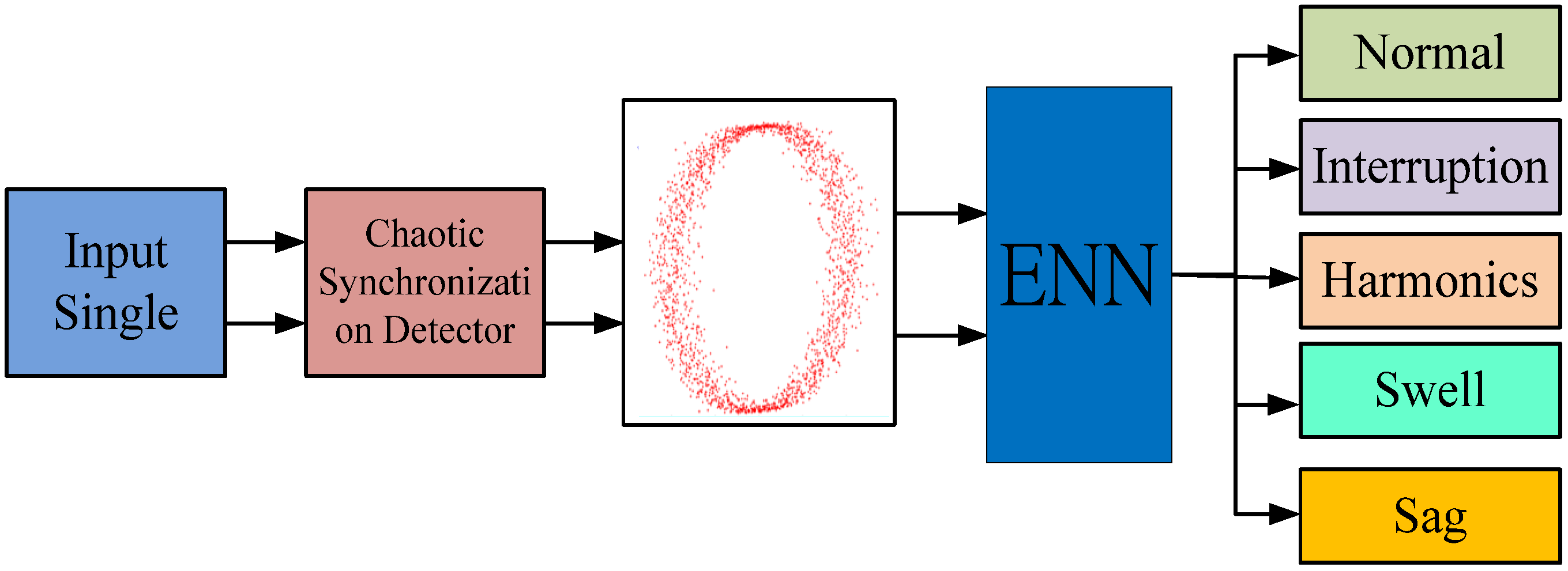
3. Proposed Power Quality Detection Method
3.1. Chaos Synchronization Detection Method

3.2. Extension Neural Network Classification Scheme
3.2.1. Structure of Extension Neural Network

3.2.2. Learning Phase
- Step 1:
- Set the connection weights between the input nodes and the output nodes in accordance with the ranges of the corresponding features in the classical domain. Note that these ranges can be obtained directly from previous experience, or determined from the training data as follows:
- Step 2:
- Read the i-th training pattern and its cluster number p:
- Step 3:
- Use the extension distance (ED) metric to calculate the distance between the input pattern Xi and the k-th cluster as follows:
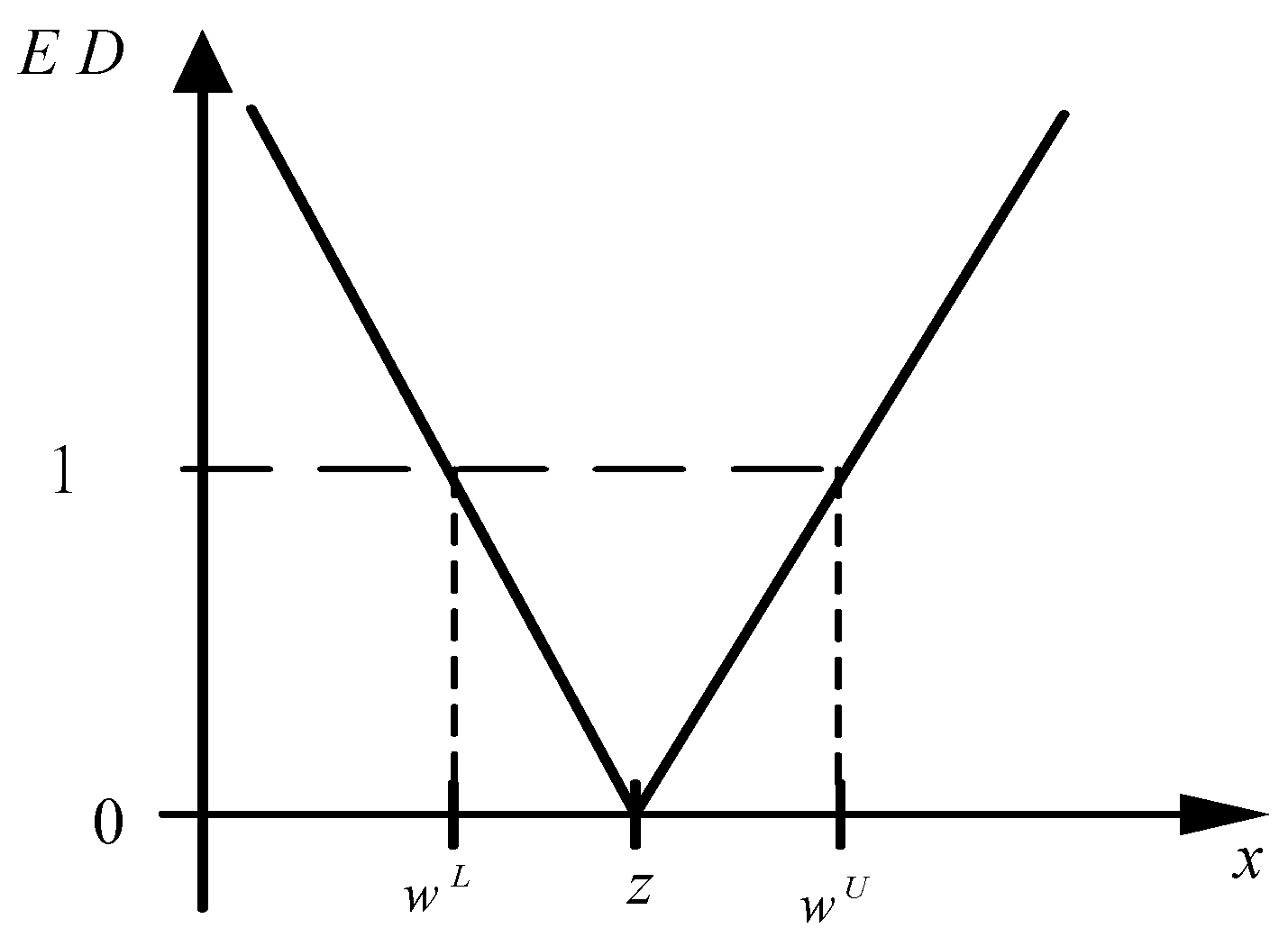
- Step 4:
- Find the cluster m which satisfies the condition EDim = min{EDik}. If m = p (where p is the target cluster for the given input), then skip to Step 6; otherwise proceed to Step 5.
- Step 5:
- Update the weights of the p-th and m-th clusters as follows:
- Step 6:
- Repeat Step 2 to Step 5 for the next training pattern. If there are no further training patterns to be classified, terminate the learning epoch.
- Step 7:
- If the clustering process has converged, or the error satisfies the predetermined criterion, terminate the learning process; else return to Step 3.
3.2.3. Operation Flowchart of Extension Neural Network
- Step 1:
- Prepare the training samples.
- Step 2:
- Construct the ENN structure with three input nodes and six output nodes.
- Step 3:
- Train the ENN using the learning algorithm described in Section 3.2.2.
- Step 4:
- Return to Step 3 if training process is not finished; else go to Step 5.
- Step 5:
- Save the connection weights of the trained ENN.
- Step 6:
- Use the trained ENN to identify the state of the power supply system signal.
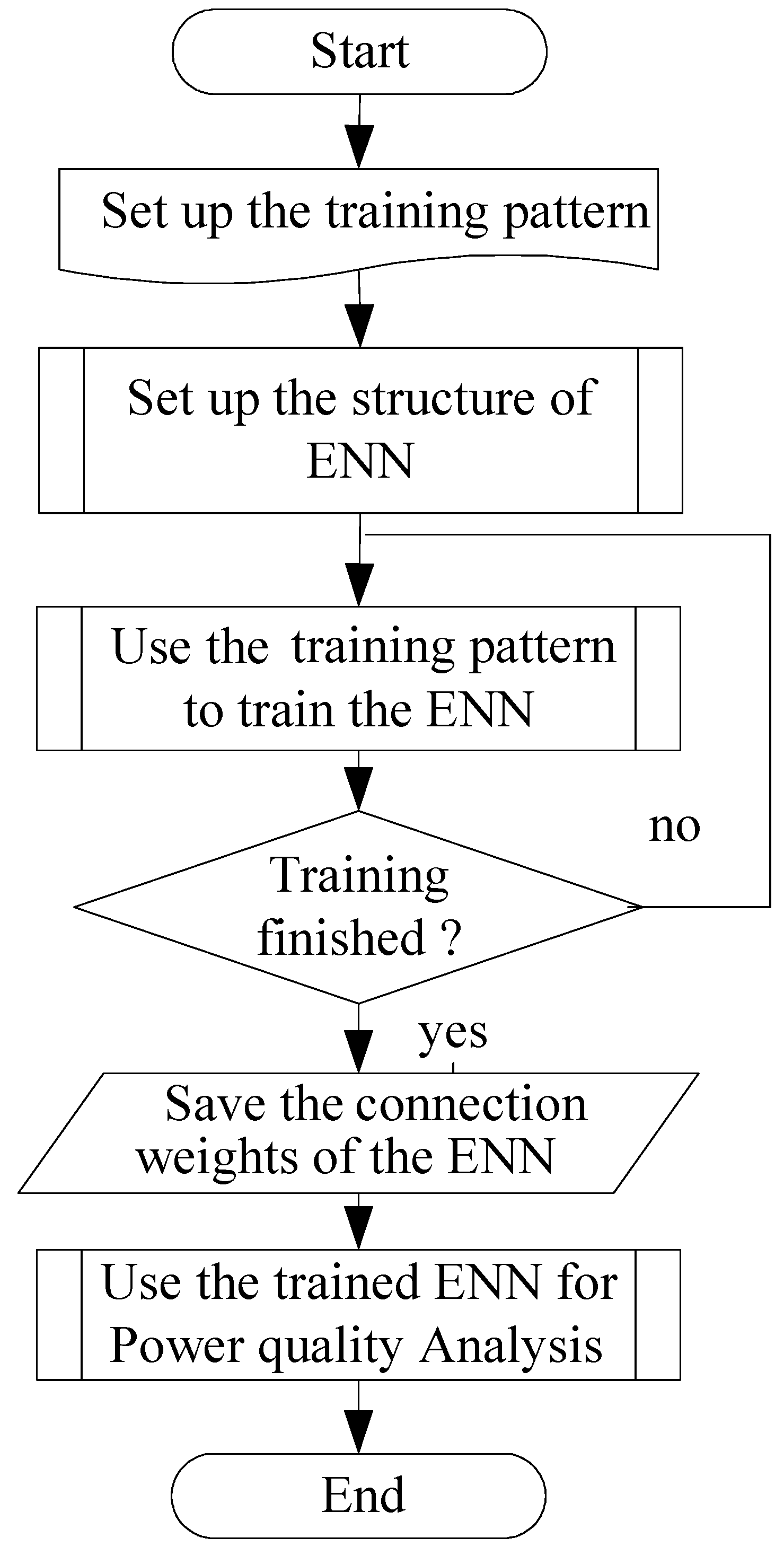
4. Simulation Results and Discussion
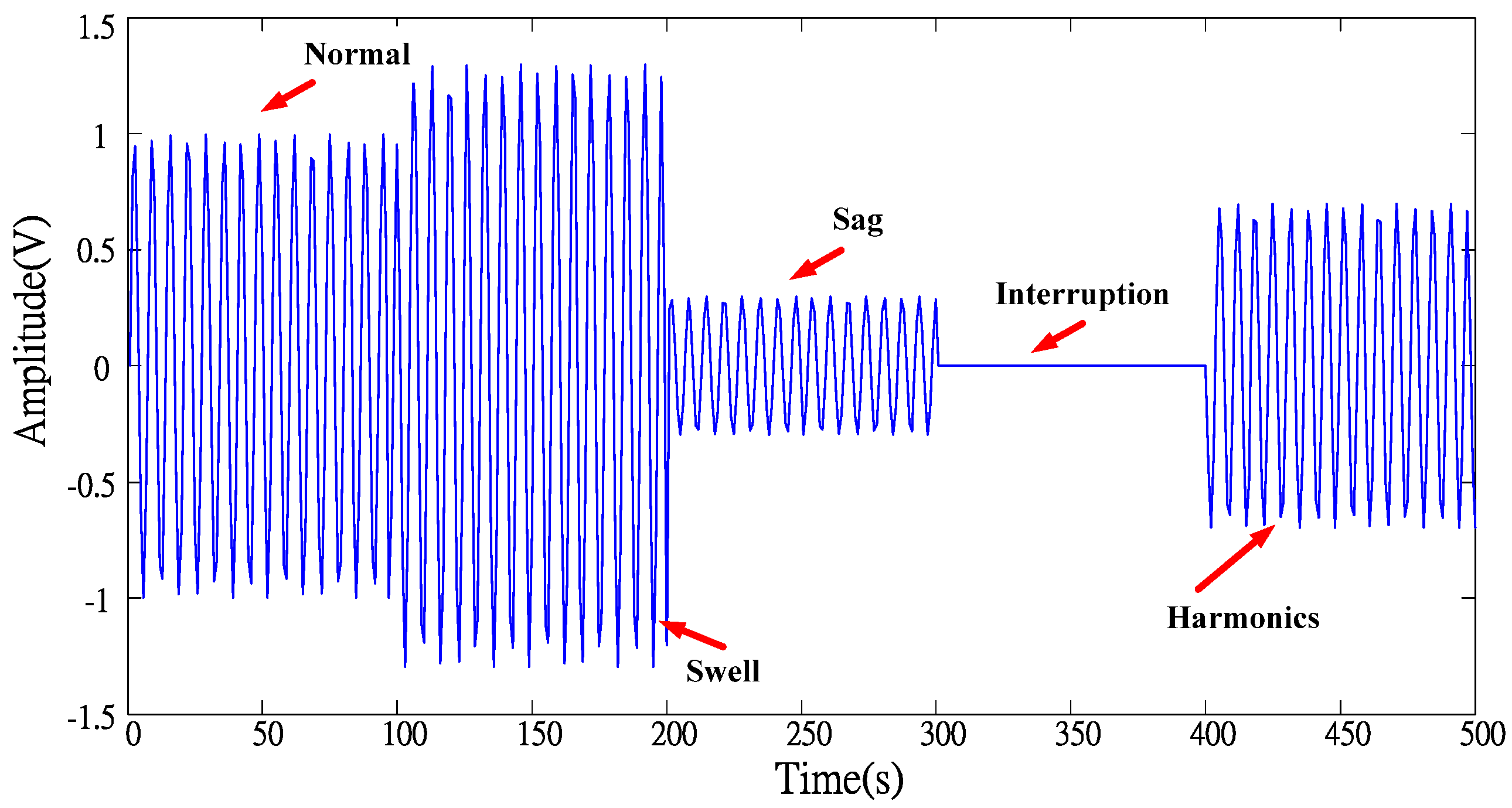
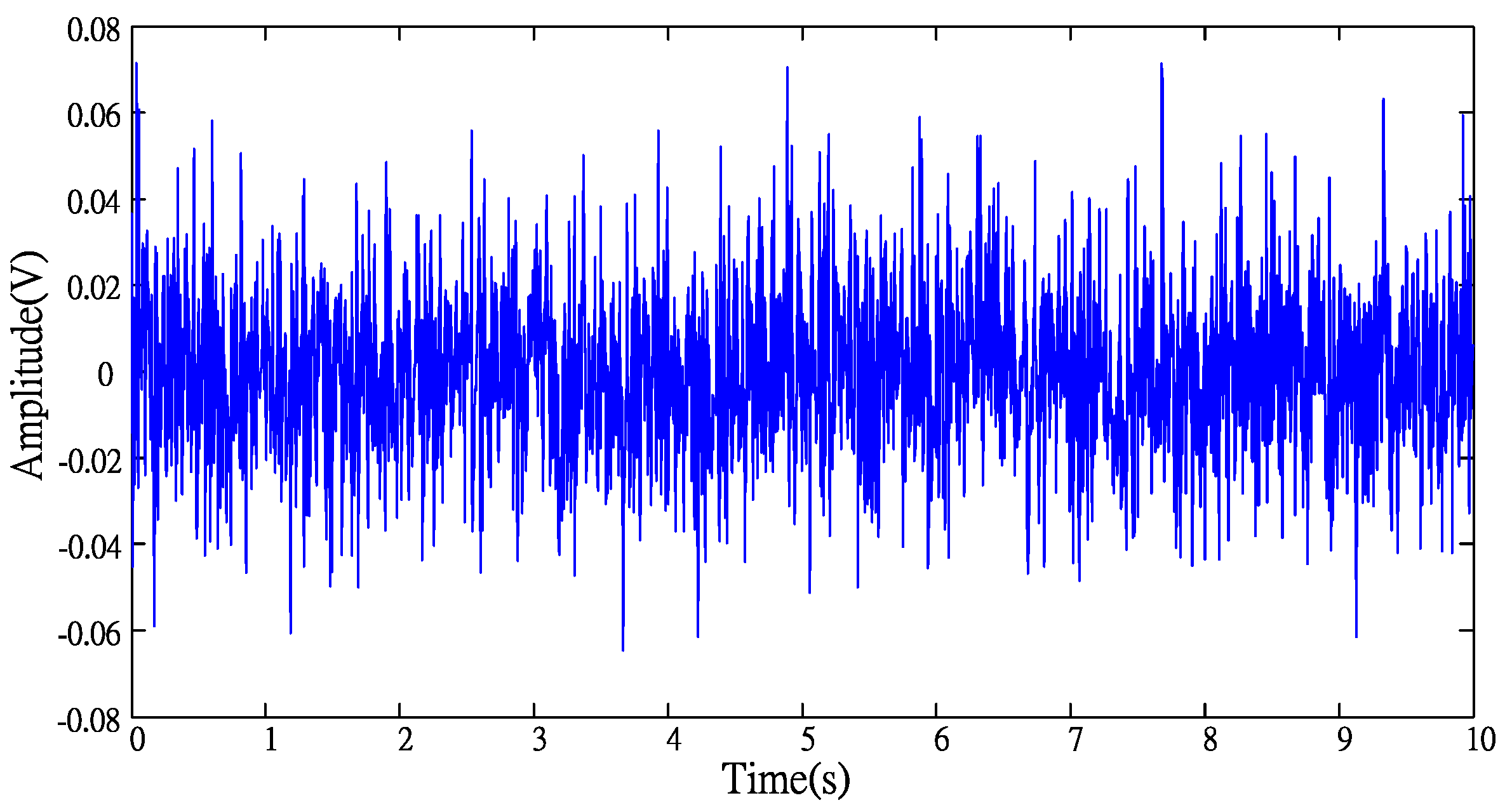

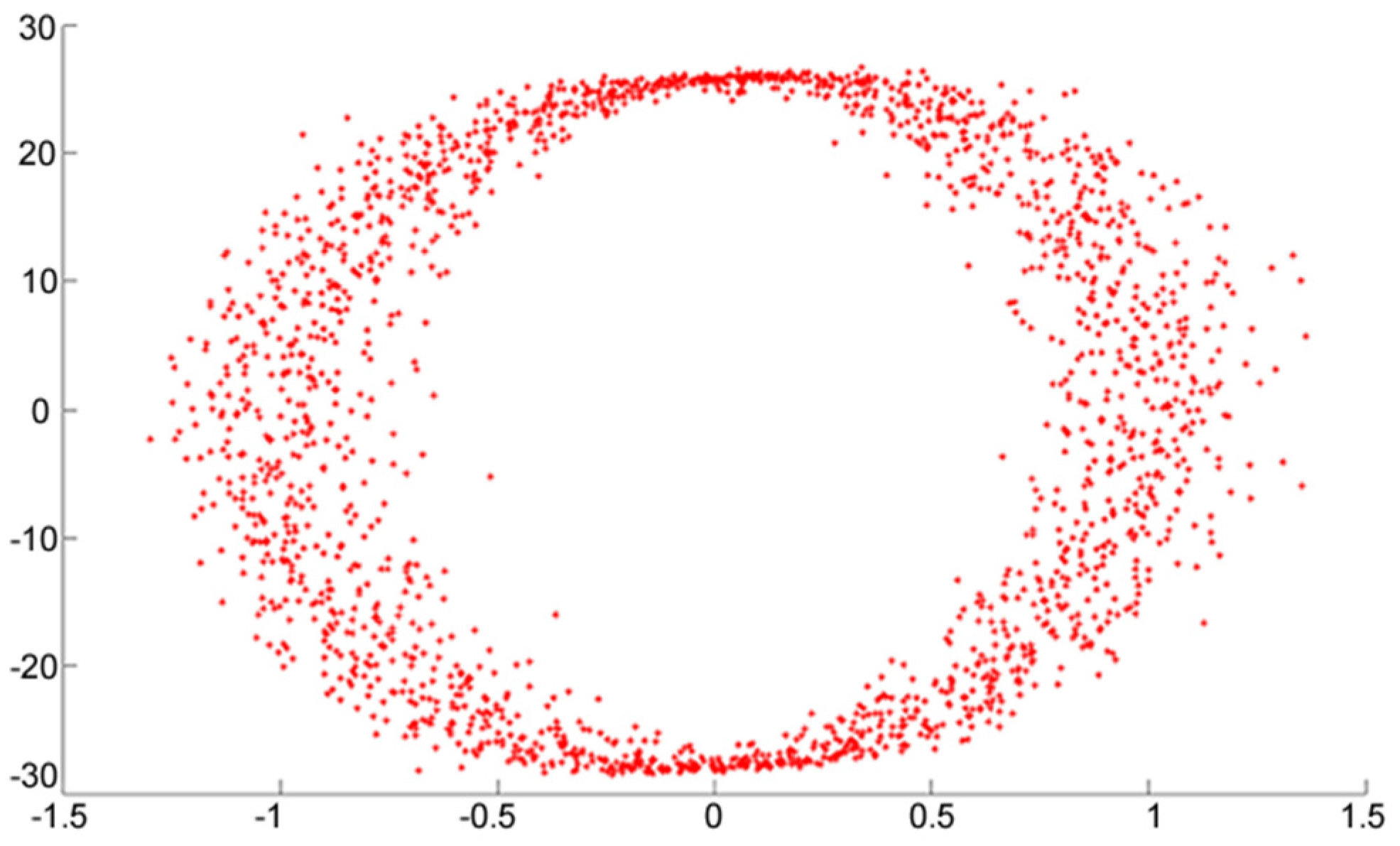
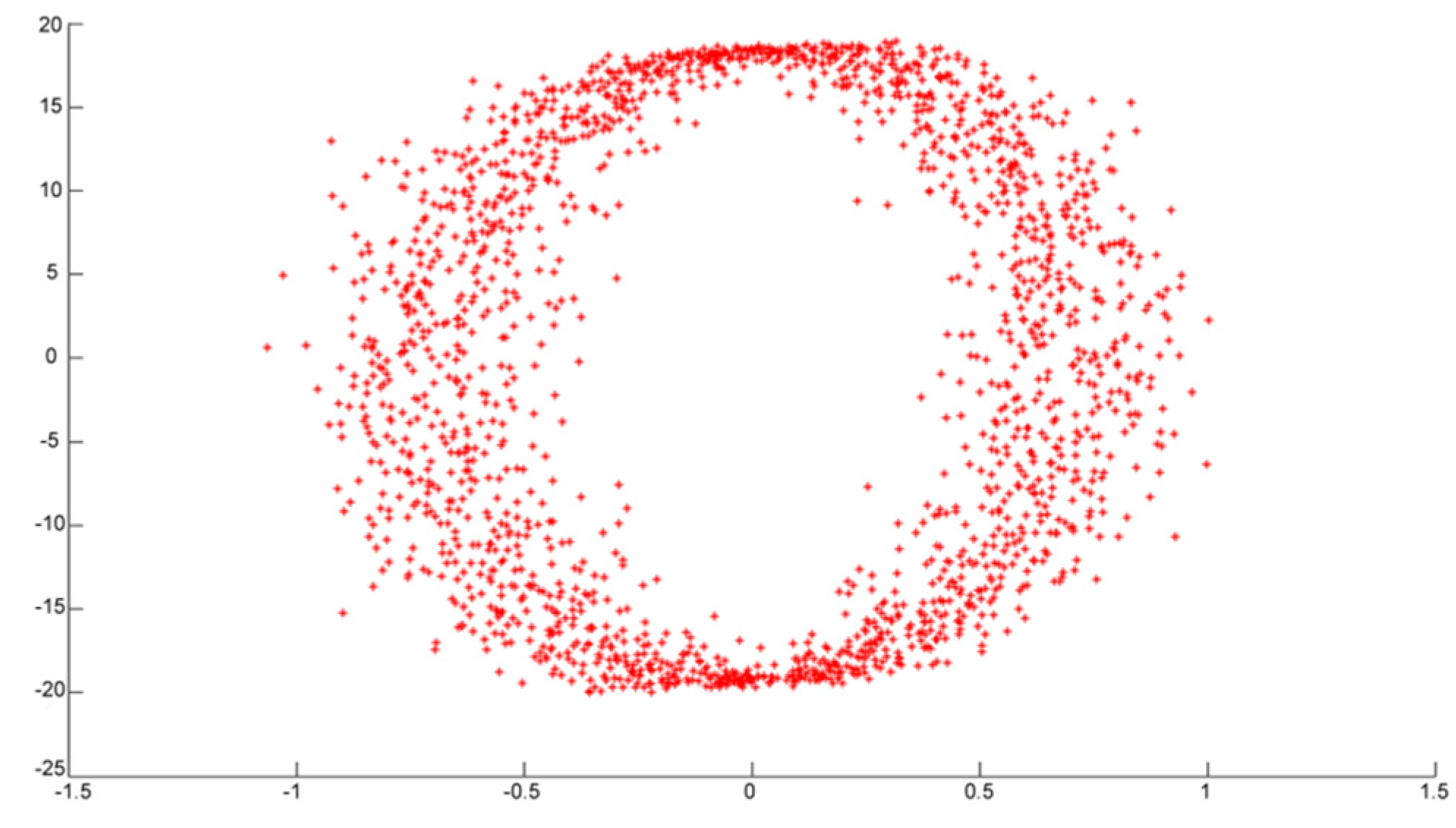



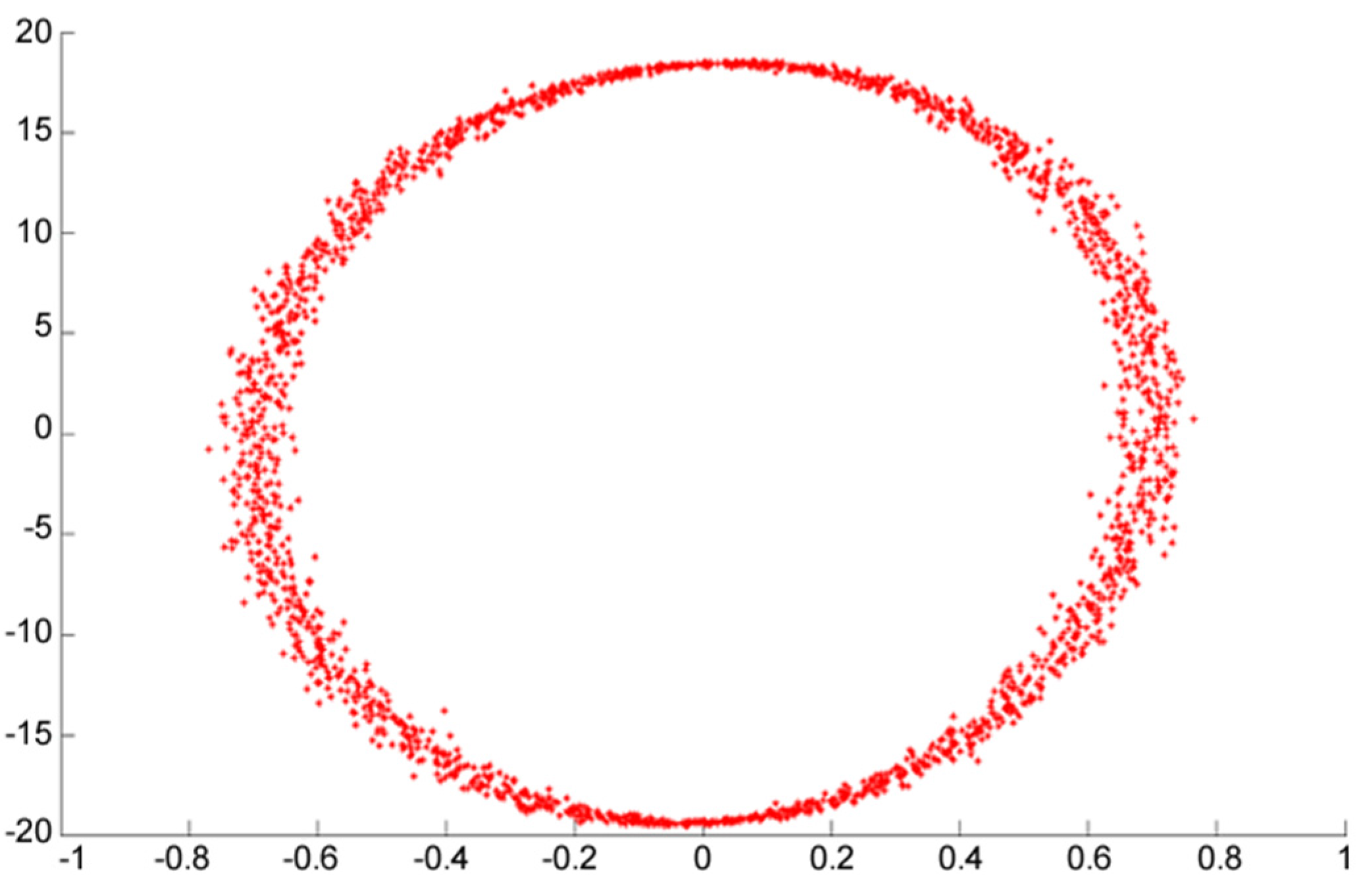
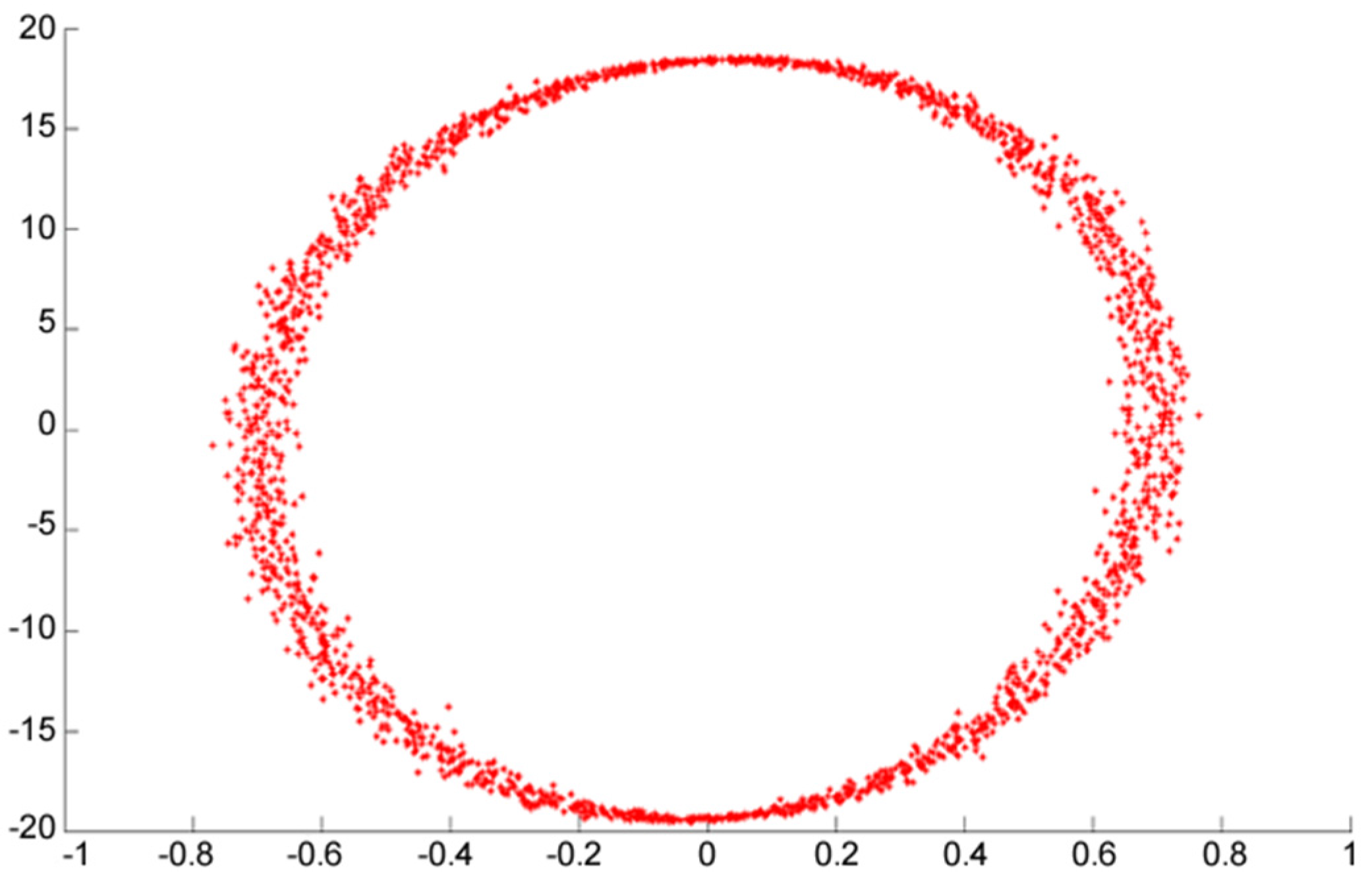
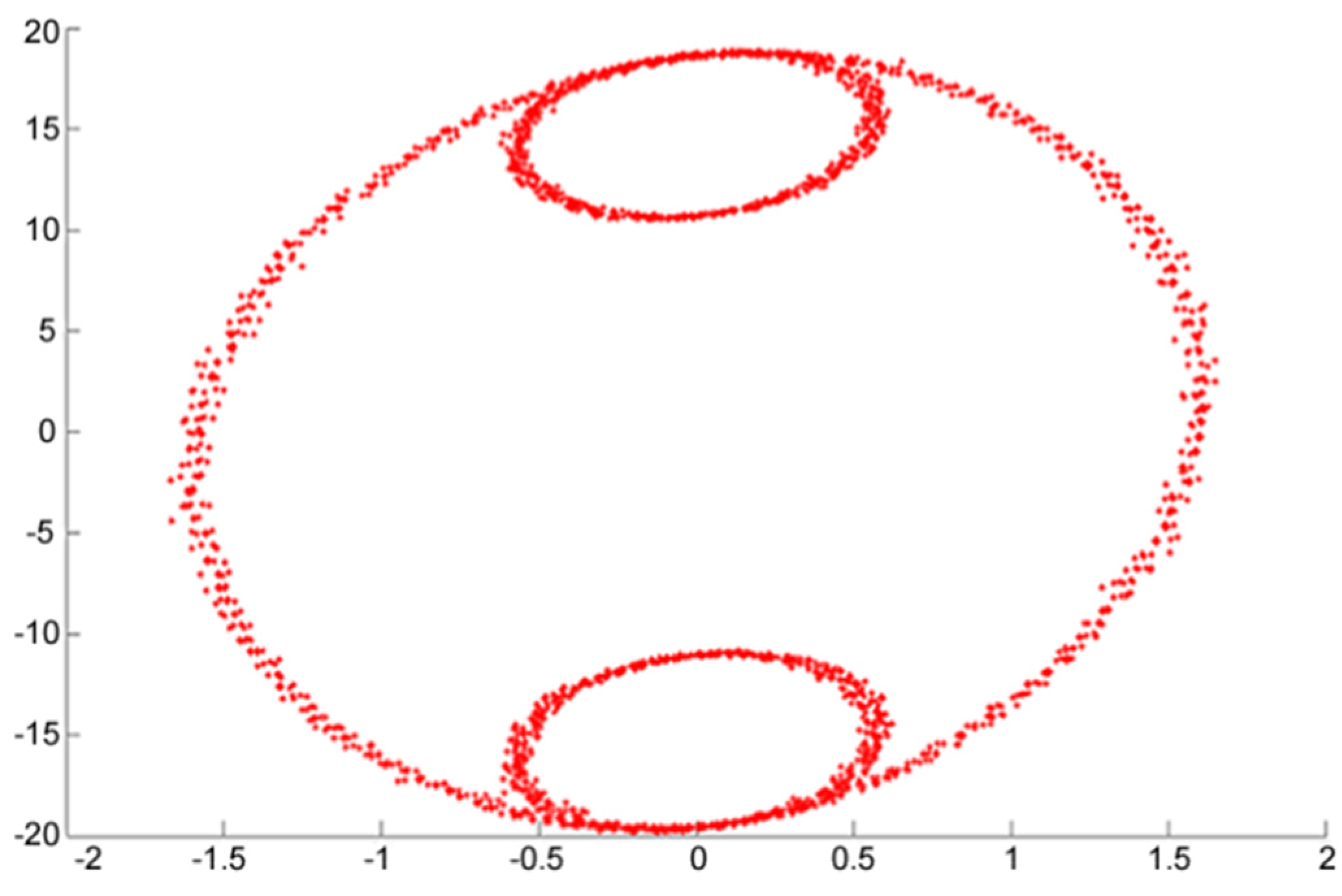
| Chaotic system signal | Lorenz | New Lorenz | Sprott | |
|---|---|---|---|---|
| Normal | With noise | 98.5% | 96% | 96% |
| Without noise | 99.5% | 97% | 98.5% | |
| Sag | With noise | 98.% | 97% | 97% |
| Without noise | 99% | 97.5% | 98% | |
| Swell | With noise | 97% | 96.5% | 96.5% |
| Without noise | 99.5% | 98.5% | 98.5% | |
| Interruption | With noise | 98.5% | 98% | 97.5% |
| Without noise | 100% | 98.5% | 99% | |
| Harmonics | With noise | 97.5% | 96% | 98% |
| Without noise | 99.5% | 98.5% | 98.5% | |
| Total average | With noise | 98.% | 96.7% | 97% |
| Without noise | 99.5% | 98% | 98.5% | |
| Testing method | Signal processing | Accuracy (%) |
|---|---|---|
| K-means clustering | Wavelet Transform | 59.2 |
| Fuzzy C-means clustering | Wavelet Transform | 61.2 |
| Extension theory | Wavelet Transform | 85.4 |
| Extension genetic algorithm | Wavelet Transform | 91.7 |
| Extension theory | Lorenz chaotic system | 97 |
| Extension Neural Network | Lorenz chaotic system | 99.5 |
| Extension Neural Network | Sprott chaotic system | 98.5 |
5. Conclusions
- (1)
- The simulation results have shown that given the use of the Lorenz chaotic system, the proposed detection method achieves an average detection accuracy of 99.5% given the absence of noise in the power system signal and 98% given the presence of 5% noise in the power signal.
- (2)
- The simulation results have confirmed that the proposed detection system can be implemented using various chaotic systems, including the Lorenz system, the New Lorenz system and the Sprott system. In addition, it has been shown that the detection systems based on the Lorenz system and Sprott system, respectively, yield a higher detection accuracy than five existing methods presented in the literature.
- (3)
- In the ENN classification scheme proposed in this study, the state of the power system signal (i.e., normal, voltage sag, voltage swell, interruption or harmonics) is identified using just three fundamental characteristics of the chaotic dynamic error waveform. Importantly, these fundamental characteristics can be reliably determined even when the power system signal is contaminated by noise. Thus, in contrast to existing methods, the proposed scheme has an improved detection performance when applied to real-world power quality monitoring and analysis applications characterized by the presence of noise.
- (4)
- The proposed ENN classification scheme has a short learning time, a rapid computation time, a low memory requirement, a high classification accuracy, and good scalability. As a result, it provides an ideal solution for the future development of hand-held power quality analyzers and real-time detection devices.
Acknowledgments
Author Contributions
Conflicts of Interest
References
- Dugan, R.C. Electrical Power Systems Quality 2E; McGraw-Hill, Inc.: New York, NY, USA, 2002. [Google Scholar]
- 1159-2009—IEEE Recommended Practices for Monitoring Electric Power Quality; Institute of Electrical and Electronics Engineers: New York, NY, USA, 2009.
- Liu, Y.Q.; Wu, G.P.; Hua, H.S.; Wang, L. Research for the effects of high-speed electrified railway traction load on power quality. In Proceedings of the 2011 4th International Conference on Electric Utility Deregulation and Restructuring and Power Technologies, Weihai, Shandong, China, 6–9 July 2011; pp. 569–573.
- Arrillaga, J.; Bradley, D.A.; Bodger, P.S. Power System Harmonics; Wiley: Hoboken, NJ, USA, 1985. [Google Scholar]
- Gilbert, D.M.; Morrison, I.F. A statistical method for the detection of power system faults. Int. J. Electr. Power Energy Syst. 1997, 19, 269–275. [Google Scholar] [CrossRef]
- Yilmaz, S.A.; Alkan, A.; Asyali, M.H. Applications of parametric spectral estimation methods on detection of power system harmonics. Electr. Power Syst. 2008, 78, 683–693. [Google Scholar] [CrossRef]
- Chen, L.J. Study of partial discharge measurement in power equipment using acoustic technique and wavelet transform. IEEE Trans. Power Deliv. 2007, 22, 1575–1580. [Google Scholar] [CrossRef]
- Santoso, S.; Grady, W.M.; Powers, E.J.; Lamoree, J.; Bhatt, S.C. Characterization of distribution power quality events with Fourier and wavelet transforms. IEEE Trans. Power Deliv. 2000, 15, 247–254. [Google Scholar] [CrossRef]
- Pei, S.C.; Yeh, M.H.; Luo, T.L. Fractional Fourier series expansion for finite signals and dual extension to discrete-time fractional Fourier transform. IEEE Trans. Signal Process. 1999, 47, 2883–2888. [Google Scholar] [CrossRef]
- Yilmaz, A.S.; Subasi, A.; Bayrak, M.; Karsli, V.M.; Ercelebi, E. Application of lifting based wavelet transforms to characterize power quality events. Electr. Power Syst. Res. 2008, 48, 683–693. [Google Scholar] [CrossRef]
- Santoso, S.; Powers, E.J.; Grady, W.M.; Hofmann, P. Power quality assessment via wavelet transform analysis. IEEE Trans. Power Deliv. 1996, 11, 924–930. [Google Scholar] [CrossRef]
- Meher, S.K.; Pradhan, A.K. Fuzzy classifiers for power quality events analysis. Electr. Power Syst. Res. 2010, 80, 71–76. [Google Scholar] [CrossRef]
- Wang, M.H.; Tseng, Y.F. A novel analytic method of power quality using extension genetic algorithm and wavelet transform. Expert Syst. Appl. 2011, 38, 12491–12496. [Google Scholar] [CrossRef]
- Su, H.S.; Zhao, F. Chaos detection method for power quality disturbance. Intell. Control Autom. 2006, 1, 5003–5007. [Google Scholar]
- Huang, C.H.; Lin, C.H.; Kuo, C. Chaos synchronization-based detector for power-quality disturbances classification in a power system. IEEE Trans. Power Deliv. 2011, 26, 944–953l. [Google Scholar] [CrossRef]
- Yalcin, M.E.; Suykens, J.A.K.; Vandewalle, J. Master slave synchronization of Lur’e systems with time-delay. Int. J. Bifurc. Chaos 2001, 11, 1707–1722. [Google Scholar] [CrossRef]
- Dash, P.K. Power quality analysis using S-transform. IEEE Trans. Power Deliv. 2003, 18, 406–411. [Google Scholar] [CrossRef]
- Lorenz, E.N. Deterministic nonperiodic flows. J. Atmos. Sci. 1963, 20, 130–141. [Google Scholar] [CrossRef]
- Yau, H.T.; Wang, C.C.; Hsieh, C.T.; Cho, C.C. Nonlinear analysis and control of the uncertain micro-electro-mechanical system by using a fuzzy sliding mode control design. Comput. Math. Appl. 2011, 61, 1912–1916. [Google Scholar] [CrossRef]
- Pecora, L.M.; Carroll, T.L. Synchronization in chaotic systems. Phys. Rev. Lett. 1990, 64, 821–824. [Google Scholar] [CrossRef] [PubMed]
- Chen, G.; Dong, X. From Chaos to Order: Methodologies, Perspectives and Applications; World Scientific: Singapore, 1998. [Google Scholar]
- Xu, D.G. Chaos synchronization between two different Sprott systems. Adv. Theory Appl. Mech. 2010, 3, 195–201. [Google Scholar]
- Balanov, A.; Janson, N.; Postnov, D.; Sosnovtseva, O. Synchronization: From Simple to Complex; Springer: Berlin, Germany, 2009. [Google Scholar]
- Bolotin, Y.; Tur, A.; Yanovsky, V. Chaos: Concepts, Control and Constructive Use; Springer: Berlin, Germany, 2009. [Google Scholar]
- Wang, M.H.; Hung, C.P. Extension neural network and its applications. Neural Netw. 2003, 16, 779–784. [Google Scholar] [CrossRef] [PubMed]
© 2014 by the authors; licensee MDPI, Basel, Switzerland. This article is an open access article distributed under the terms and conditions of the Creative Commons Attribution license (http://creativecommons.org/licenses/by/4.0/).
Share and Cite
Wang, M.-H.; Yau, H.-T. New Power Quality Analysis Method Based on Chaos Synchronization and Extension Neural Network. Energies 2014, 7, 6340-6357. https://doi.org/10.3390/en7106340
Wang M-H, Yau H-T. New Power Quality Analysis Method Based on Chaos Synchronization and Extension Neural Network. Energies. 2014; 7(10):6340-6357. https://doi.org/10.3390/en7106340
Chicago/Turabian StyleWang, Meng-Hui, and Her-Terng Yau. 2014. "New Power Quality Analysis Method Based on Chaos Synchronization and Extension Neural Network" Energies 7, no. 10: 6340-6357. https://doi.org/10.3390/en7106340




